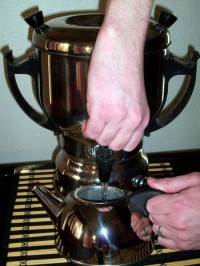Russia is a great tea-drinking nation, and no Russian living-room is complete without the distinctive samovar bubbling away in the corner. Ever-present in the home interiors of Tolstoy and Dostoevsky novels, the  appliance remains a fixture of Russian contemporary life, from Moscow to Siberia.
appliance remains a fixture of Russian contemporary life, from Moscow to Siberia.
The one concession to modernity is that nowadays it is usually heated electrically, rather than by burning coal underneath it. And who can blame the Russians for not making many changes to a winning formula? The samovar is a simple but brilliant way of preparing tea, as well as being a source of cultural pride.
A samovar is essentially a big, vase-shaped kettle for containing hot water, with a tap on the side to dispense the water. Its upper surface has a flat area, perforated with steam holes, on which a teapot perches. The tea inside the teapot is generally brewed pretty strong. Having poured themselves some tea from this pot, drinkers can then dilute it with additional hot water from the kettle until the drink is just the strength they desire. That’s one of the great things about the samovar’s design. Another is that you can leave it on a low temperature setting for hours on end, ensuring a steady supply of warmth not only to the water in the kettle, but also to the teapot on top of it. That means you can leave the pot to draw for longer than is customary in the west, ensuring a nice rich brew.
The word “samovar” means literally “self-cooking.” An apt name, given that the heating of the water and the preparation of the infusion are all contained in one free-standing contraption.
To make your tea, first fill the kettle with a few pints of water. Plug it in (or light your coals), and turn the thermostat to the highest setting to get the water boiling as quickly as possible. Meanwhile, put tea leaves in the tube-shaped infuser that goes down in the center of the teapot.
 When the water boils, open the kettle’s tap and put the teapot underneath it to fill it with water. Then put the teapot in its assigned place on top of the appliance. Turn down the thermostat so that the water in the kettle will keep simmering for however long you need it to.
When the water boils, open the kettle’s tap and put the teapot underneath it to fill it with water. Then put the teapot in its assigned place on top of the appliance. Turn down the thermostat so that the water in the kettle will keep simmering for however long you need it to.
The cups in which tea is served in Russia are often rather stylish, diminutive things made of glass with metal handles. Some Russians like to pour their tea from the cup into the saucer and then slurp it up. Those who like their tea sweet will sometimes hold a sugar lump in their fingers or accompany the tea with some jam, rather than actually stirring sugar into the beverage. But you don’t need to follow any of these Russian customs in order to enjoy the advantages of making tea with a samovar.
And those advantages are not only practical, but also esthetic. There is something very reassuring about the look of a samovar, which complements perfectly the refreshing experience of drinking tea. It somehow combines otherworldly elegance and a homey sense of comfort: a quiet, soothing presence in the background of life.
Written by David Hill for EuropeUpClose.com

H Galea
Tuesday 14th of September 2010
Where can samovars be bought?
How about coffee, still using the old system, of filling the glass with half coffee and half coffee granules. I experienced it in St Petersburg. I nearly got choked, anyhow, was not experienced enough how you make coffee. Nice place St Petersburg.